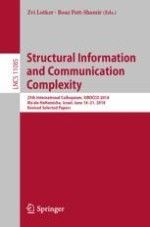2018 | Book
Structural Information and Communication Complexity
25th International Colloquium, SIROCCO 2018, Ma'ale HaHamisha, Israel, June 18-21, 2018, Revised Selected Papers
Editors: Zvi Lotker, Boaz Patt-Shamir
Publisher: Springer International Publishing
Book Series : Lecture Notes in Computer Science
